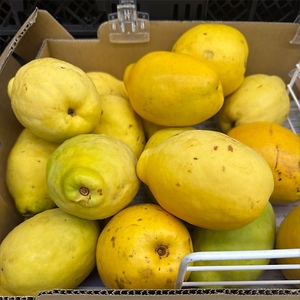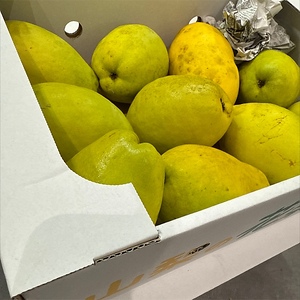


Chinese Quince
Estimated Inventory, lb : 0
Description/Taste
Chinese quince is variable in size, depending on growing conditions, and average 12 to 17 centimeters in length and 350 to 500 grams in weight. The fruits bear an oval, oblong, to sometimes papaya-like shape with blunt, curved to slightly tapered ends. Chinese quinces have smooth, glossy, and firm skin, ripening from green to shades of bright golden yellow. The fruit’s surface also develops a sticky texture with maturity. Underneath the skin, the light yellow to orange-yellow flesh is dense, hard, and granular. The flesh also envelops five central chambers filled with many seeds. Chinese quinces are not edible raw due to their high tannin content, creating a bitter and astringent flavor. Cooking dissipates these tannins and the flesh transforms in coloring to a red-pink hue. The flesh also becomes soft and tender when cooked. Chinese quinces are known for their permeating fragrance. The scent is said to be a combination of fruity and floral nuances reminiscent of pears, apples, and peaches. Select Chinese quinces that are heavy for their size, have even coloring, and a strong aroma. Cooked Chinese quince has a mellow, sweet, fruity, and subtly floral taste.
Seasons/Availability
Chinese quince is harvested in the fall, typically between October through early December.
Current Facts
Chinese quince, botanically classified as Pseudocydonia sinensis, is a fruiting species native to Asia, belonging to the Rosaceae family. The fruits grow on deciduous trees reaching 6 to 18 meters in height and are a favored garden tree in East Asia for its ornamental properties and edible fruits. Chinese quince trees are somewhat resistant to cold temperatures and produce brilliantly colored five-petaled flowers in the spring. Later in the fall, oval to oblong, bright yellow fruits appear, adding to the tree’s ornamental nature and functional qualities. Chinese quince has been traditionally revered for its use in natural medicines, culinary recipes, and cultural practices. The fruits are known as Mùguā in China, Mokgwa, Mogwa-namu, and Mogwa in Korea, and Karin or Wamokka in Japan. It is important to note that Chinese quince is distinct from the quince commonly grown in Europe and the Americas, classified as Cydonia oblonga. Chinese quince is typically more oval to oblong and has smooth skin, while most of the quince varieties in the western world have a round to pyriform shape with fuzz-coated skin. The trees are also distinguished as Chinese quince by their serrated leaves and flowers that grow individually, not in clusters. Chinese quince is grown and harvested as a delicacy throughout East Asia and are a versatile ingredient utilized for a wide array of sweet and savory culinary preparations.
Nutritional Value
Chinese quince is a source of vitamin C to strengthen the immune system, fiber to regulate the digestive tract, and potassium to balance fluid levels within the body. The species also provides various polyphenols, which carry antioxidant-like properties to reduce inflammation and protect the cells against the damage caused by free radicals. In Traditional Chinese Medicine, Chinese quince is utilized in extracts and lozenges for coughs and sore throats. The species is also believed to boost overall health, improve complexion, and fight against fatigue.
Applications
Chinese quince must be cooked and develops a mellow, sweet, fruity, and floral taste. The fruits are astringent and full of tannins when raw, but these characteristics dissipate with heat and the flesh transforms into a ruby-red to pink hue. Chinese quince is traditionally peeled and simmered in a mixture of sugar and spices to develop a sweet, rich flavoring. In East Asia, Chinese quince is popularly infused into syrups or preserved in a tangy, sweet mixture to make honey pickles. Chinese quince is also high in pectin, allowing the fruits to be made into jellies, jams, and preserves. These jams can be spread over toast, served with desserts, or eaten on charcuterie boards with fresh cheeses, nuts, and meats. In addition to jams, Chinese quince is combined with apples and cooked into pies, or they can be preserved for extended use. Some recipes mention adding quince extract into sorbets or infusing into fruity tea. Beyond sweet preparations, Chinese quince can be mixed into stews and soups to add a sweet flavoring. The species is also famous for making a type of wine, consumed as a digestif. Chinese quince pairs well with yuzu, apples, pears, ginger, peanuts, brown sugar, cinnamon, nutmeg, cloves, and oats. Whole, unwashed Chinese quince should be stored in a cool and dark place. The fruit should be ripened before cooking but does not need to be stored in the refrigerator. Once ripe, it is recommended to immediately consume the fruits for the best quality and flavor.
Ethnic/Cultural Info
Chinese quince is a symbol for happiness, good luck, and prosperity throughout East Asia. In China, the aromatic fruits are given as gifts to friends and family during special occasions to welcome luck and fortune. The trees are also highly ornamental and are planted throughout garden landscapes, including some temple grounds. The colorful blossoms are seen as a symbol of spring, and the fruits in the fall are favored for their coloring and aroma. The trees are also believed to attract good energy, making garden spaces a place for happiness. In Japan, the name for Chinese quince, Karin, sounds similar to the word karinu, meaning “not borrowing.” This similar sound has led Chinese quince trees to symbolize freedom from debt, and families plant the trees in their yards to keep themselves financially independent. Beyond its positive symbolism, Chinese quince trees are revered throughout East Asia for their durable hard wood. The wood is used as a construction material to make furniture, musical instruments, frames, and other wooden pieces.
Geography/History
Chinese quince is native to China and has been growing wild since ancient times. The exact origins are unknown, but scientists hypothesize that the species may have arisen from the provinces of Hubei and Zhejiang in China. Historically, Chinese quince has been mentioned in several medicinal texts, some as early as the 3rd century BCE, and was later featured in the “Compendium of Materia Medica,” written by Li Shizhen in the late 16th century. The species was introduced from China to Japan sometime during the Heian period, between 794 and 1185 CE, and was rumored to have been planted by Kobo Daishi, a Japanese Buddhist monk who resided in China during the Tang Dynasty. Chinese quince spread in cultivation across Japan and became a popular garden tree during the Edo Period, 1603 to 1868 CE. Similarly to its uses in China, the species was extensively used in Japan for its culinary and medicinal properties. During the 1970s, Chinese quince became well-known throughout East Asia when studies concluded that elements in the fruits could help sore throats and coughs. Companies began using Chinese quince in various cough medicines and throat lozenges, expanding the fruit’s notoriety and popularity. Today, Chinese quince is cultivated throughout East Asia, especially in China, Japan, and Korea. It is sometimes seen in small populations in Europe but is mostly rare outside of Asia. When in season, Chinese quince fruits are sold through local fresh markets and directly through growers. They are not found in commercial retailers but are sometimes sold through online sites. In Japan, Chinese quince is grown in the Nagano, Kagawa, Yamagata, Ehime, and Yamanashi Prefectures.









